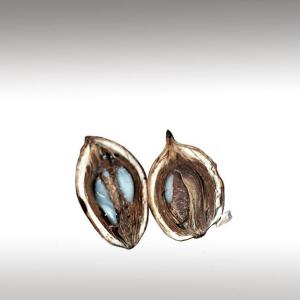
BABASSU SEED OIL (ATTALEA SPECIOSA) - BASE OILS

BASE / GENERAL DATA
Information submited: January 31, 2015 Modified: April 3, 2018 By: OperaDreamhouse
Attalea Speciosa (Babassu, Babassu Palm, Babaçu, Cusi) is a palm native to the Amazon Rainforest region in South America. The Babassu Palm is the predominant species in the Maranhão Babaçu forests of Maranhão and Piauí states. It is generally found in tropical humid climates, along rivers and valley floors.
Babassu is an erect perennial evergreen palm, reaching 15 to 30 m high. The trunk is slender, ringed with leaf scars 20 - 50 cm in diameter. A dense rounded crown, 8 m in diameter, is formed by 15 - 20 huge leaves up to 9 m long. Bunches are 1 m long, weigh 40 - 90 kg and bear 250 to 600 fruits twice a year. The fruits are oblong nuts (8 -15 cm long x 5 - 9 cm broad) containing 3 - 8 kernels surrounded by fleshy pulp and a hard woody shell, similar to the Coconut shell.
Babassu starts yielding after 8 years and reaches full production within 15 - 20 years. One ton of nuts yield 10 % kernels containing 60 - 70 % oil. In Brazil, mature fruits start to drop between August and November and continue to fall until the rainy season begins in January and February.
Because Babassu trees grow in dense jungles, the collection and transport of the nuts is difficult.
The kernels must be well dried before oil extraction in order to prevent rancidity. Most of the kernel removal is still done by hand. Its seeds yield a kind of oil commercially known as Babassu oil. In order to extract it, the seeds, picked from spontaneously grown palms, are ground and squeezed by means of hydraulic presses.
This oil, whose content per seed ranges between 60% and 70%, looks transparent, it smells like Walnuts and turns liquid at 20 - 30°C, otherwise it is somewhat creamy. As it is not greasy and possesses remarkable softening properties, Babassu oil is widely employed, notably to prepare cosmetics. Like Coconut oil, unrefined Babassu oil is solid at room temperature.
It is high in lauric and myristic acid.
Babassu is an erect perennial evergreen palm, reaching 15 to 30 m high. The trunk is slender, ringed with leaf scars 20 - 50 cm in diameter. A dense rounded crown, 8 m in diameter, is formed by 15 - 20 huge leaves up to 9 m long. Bunches are 1 m long, weigh 40 - 90 kg and bear 250 to 600 fruits twice a year. The fruits are oblong nuts (8 -15 cm long x 5 - 9 cm broad) containing 3 - 8 kernels surrounded by fleshy pulp and a hard woody shell, similar to the Coconut shell.
Babassu starts yielding after 8 years and reaches full production within 15 - 20 years. One ton of nuts yield 10 % kernels containing 60 - 70 % oil. In Brazil, mature fruits start to drop between August and November and continue to fall until the rainy season begins in January and February.
Because Babassu trees grow in dense jungles, the collection and transport of the nuts is difficult.
The kernels must be well dried before oil extraction in order to prevent rancidity. Most of the kernel removal is still done by hand. Its seeds yield a kind of oil commercially known as Babassu oil. In order to extract it, the seeds, picked from spontaneously grown palms, are ground and squeezed by means of hydraulic presses.
This oil, whose content per seed ranges between 60% and 70%, looks transparent, it smells like Walnuts and turns liquid at 20 - 30°C, otherwise it is somewhat creamy. As it is not greasy and possesses remarkable softening properties, Babassu oil is widely employed, notably to prepare cosmetics. Like Coconut oil, unrefined Babassu oil is solid at room temperature.
It is high in lauric and myristic acid.

SPIRITUAL PRACTISES DATA

MEDICINE / HEALTH DATA

BEAUTY / COSMETICS DATA

FOOD / COOKING DATA
COMMENTS
No comments.


